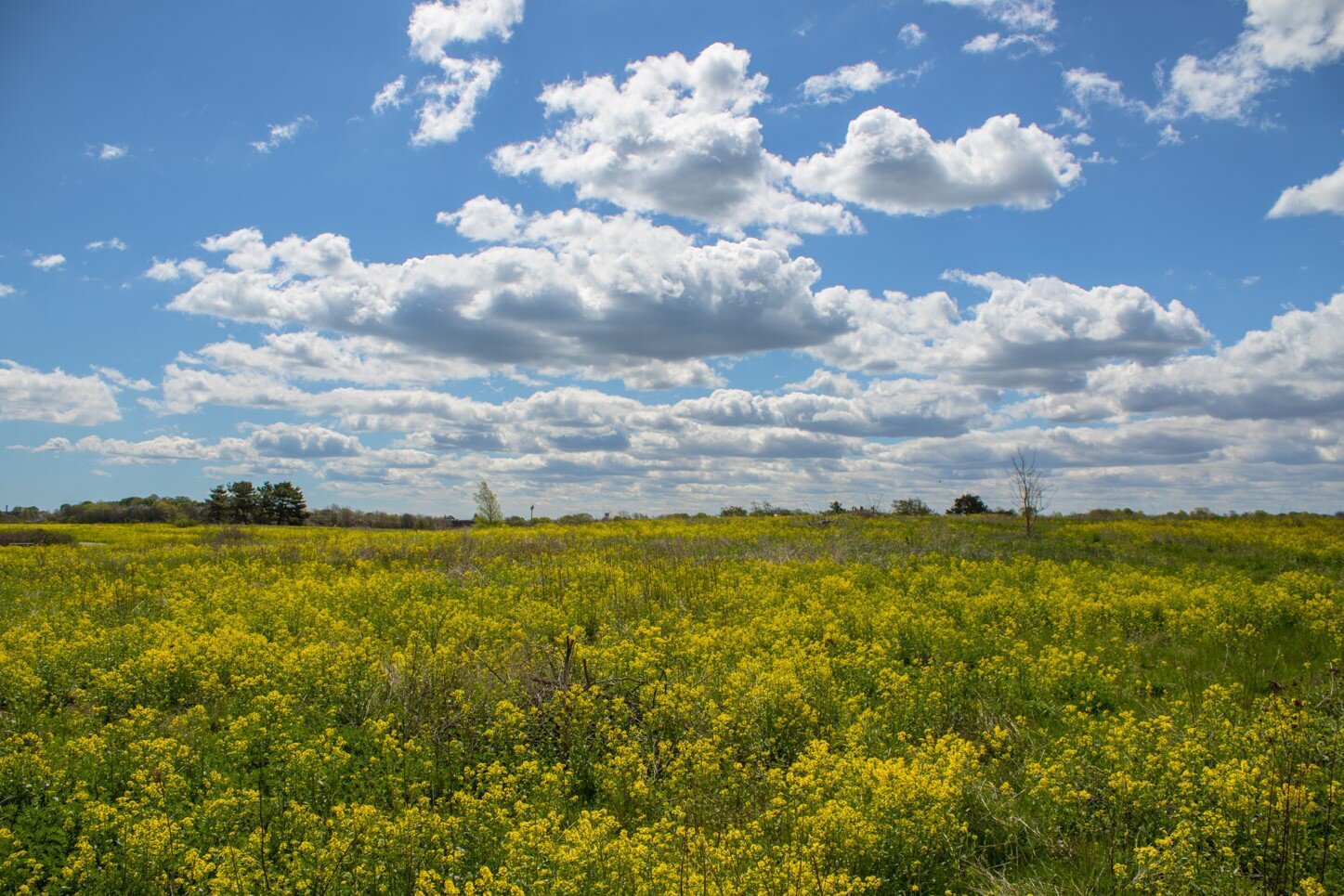Belle Isle Marsh: The last remaining salt marsh in Boston
This guest blog comes from Sean Riley, Forest and Park Supervisor for the Department of Conservation and Recreation’s (DCR) Belle Isle Marsh Reservation and Rumney Marsh. Every summer One Waterfront’s youth program, the Waterfront Ambassadors, visit Belle Isle Marsh to help with conservation and restoration projects, and to learn about the important work being done around the state by DCR. In this blog, Sean describes the history and ecology of Belle Isle, Boston’s last remaining salt marsh, and the special partnership between DCR and One Waterfront.
***
Saltmarsh Sparrow in Belle Isle Marsh (Photo courtesy Sean Riley/DCR)
Belle Isle Marsh Reservation has a long and interesting history. Starting as an island in the mid 1600’s, the site changed ownership numerous times and was called: Hogg Island, then Breeds Island, and finally, Belle Isle in the late 1800’s. The site’s use was predominately for livestock and agriculture like most salt marshes at the time. From 1952-1971, the site was a drive-in movie theatre, before being acquired by the MDC in 1975.
Currently the reservation is protected as the last remaining salt marsh in Boston. Belle Isle Marsh Reservation was officially opened in September of 1986, by what was, at the time, The Metropolitan District Commission (MDC). The site was designated an Area of Critical Environmental Concern (ACEC) in 1988, as part of the larger Rumney Marshes ACEC.
The MDC later became the Department of Conservation & Recreation (DCR), which currently owns and manages the reservation today. The initial protection and push for the acquisition of the site was done via The Friends of Belle Isle Marsh. Originally, The Friends were founded in the early 1980s, by a group of naturalists that had been involved in monitoring the many birds found in the marsh since the 1970s. The Friends group (FBIM) have continued to be instrumental in protecting the reservation from the time before the acquisition of the park by the MDC, to the present. Today, the reservation is comprised of approximately 300 acres, and is located in Winthrop, Revere and East Boston. While DCR is the primary land owner, there are small parcels owned by the surrounding towns and cities.
The Belle Isle Marsh Reservation is a fragmented reservation, requiring a vehicle to get to the various satellite areas unless visitors have the wherewithal to walk it. What is considered the main part of the reservation is accessed from Bennington Street in East Boston. Once in the reservation, it is not hard to see why it has captivated so many people over the years. Belle Isle is now an oasis of green, settled in the middle of sprawling urban development.
Belle Isle Marsh Meadow (Photo courtesy Sean Riley/DCR)
As people enter the main park they are immediately greeted by a 13 acre meadow, while not large, in the grand scheme of grasslands, it is the largest natural meadow in the abutting towns. As such, the meadow is a hub for pollinators and other native wildlife. In the early spring, this meadow is a blazing yellow, from the wild mustard which flowers in early May. There are roughly 130 acres of salt marsh, and some upland areas which consist of coastal thickets and even some mid canopy woodlands. Other popular features are a 120 foot boardwalk lookout, and a 25 foot observation tower which gives a panoramic view of the reservation and the Boston skyline. The park is one of the most biologically important areas in the greater Boston area. In addition to being an ACEC, it is also an Important Bird Area (IBA) an international designation for significant bird biodiversity areas. Over 250 species of birds have been seen in the reservation, and it is home to state and federally listed species during the breeding season, during spring and fall migration, and during the winter months.
I count myself very lucky to be able to spend so much time in this magical place. I have personally seen 197 species of birds in the park. It is not uncommon to stumble across Snowy Owls in the winter, see an Eastern Coyote hunting voles in the meadow in spring, or hear the buzz of the critically threatened Saltmarsh Sparrow in the marsh, during the summer. For a bird watcher it can be paradise, and for the local community it provides a quiet place to connect with nature, transporting visitors out of the bustling sounds of the city. As a place with profound natural beauty, it is easy to understand why so many people love this reservation. However, that beauty takes a lot of work to maintain and many working partners to achieve it. One such long standing partnership is with The Trustees of Reservations. Each summer we at DCR work with the Trustees, and their Boston Waterfront Initiative youth conservation group, now called the Waterfront Ambassadors, who take part in projects related to resilience, community outreach, and local climate change impacts. Staff from the Trustees and their youth workers come to the reservation and help with conservation and restoration efforts, while learning some of the skills that we use to manage our state parks and serve the public.
Osprey nest in Belle Isle Marsh (Photo courtesy Sean Riley/DCR)
Over the years we have done some really fun projects and completed a lot of important work together. Previous seasons we have worked on projects such as observation platforms, trail work, bog bridges, invasive plant management and habitat restoration, plant and animal surveys, canoe trips and bird boxes. One of my favorite endeavors to date was the building and installing of a new Osprey platform. We built the platform at the office and then everyone trekked out into the middle of the marsh with shovels and a few hundred pounds of equipment and installed the 12-foot nesting platform. The following spring a young pair of Osprey claimed the new platform, and after a few thousand miles of migration, they have returned again this year to use the platform built by the ambassadors-a rewarding project that helps with wildlife stewardship for years to come!
The Belle Isle Marsh Reservation is a home to thousands of species of animals and the local green space for thousands of families, but this special place has a difficult road ahead. With the exponential expansion of local development and the challenges of climate change, now more than ever, the reservation needs increased protections and investments in its future. Coastal Marshes are being hard hit by sea level rise, and the ecology of these sites is changing faster than many species can adapt. So please get outside and enjoy these special places, where you can with responsible social distancing, volunteer some time to help with conservation efforts, and support groups like the Trustees and state entities like The Department of Conservation and Recreation for the continued stewardship of our wild spaces.
(Above: Photos courtesy Sean Riley/DCR)
About the author: Sean Riley is a lifelong avid bird watcher and naturalist currently residing in Georgetown Massachusetts. He is the manager for the Belle Isle Marsh Reservation & The Rumney Marsh Reservation at the Department of Conservation and Recreation (DCR), and leads birding programs for DCR and Mass Audubon. Additionally, Sean has been involved in studying of a number of Massachusetts Owl species for nearly a decade, with both banding efforts and annual population density surveys.








